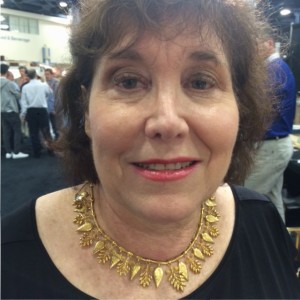The Original Miami Beach Antique Show in Miami every January abounds with enticements.

There are football fields’ worth of antique jewelry, furniture, paintings and decorative arts. I mostly concentrate on the jewelry, and the range of design, gems and beautifully crafted work is incredible. This is the largest indoor show in the United States, and you can find almost anything you can imagine from American artists.
Just as important, the U.S. Antique Show sponsors the Jewelry History Series, a two-day conference held before most buyers and browsers arrive. Author, independent curator and co-founder of the Association for the Study of Jewelry and Related Art, Elyse Zorn Karlin, has organized it since its inception three years ago. This year she was joined by Gayle Brett Levine, Executive Director of the National Association of Jewelry Appraisers. This year’s conference attendees came from as far away as Australia, and in addition to myself and a colleague, there were several others who traveled from the west coast to attend.
Why we love jewelry
The conference emphasizes how jewelry intersects with and reflects cultures and societies. Perhaps you can’t have one without the other. Whether it’s war or changes in monarchies or legislation or new tools, artists of the age embed current outlooks in their jewelry. And the jewelry itself is also sometimes a force of culture. One seminar concerned “pinchbeck,” the mock-gold alloy of copper and zinc. Until the mid-1800s, only jewelry of 18-carat gold could be sold, so the creation of a substitute, invented by Christopher Pinchbeck, allowed ordinary people to buy “gold-effect” jewelry on a budget.
Another overarching message was this: Everything old is new again. Visit the ancient jewelry gallery at The Getty Villa. You could pluck out and wear any piece from the case and anyone who looked at it would think you bought it yesterday. The modern jewelry you see on folks walking down the street will feature the same designs as the ancients’. Classics continue to appeal to us, and we keep reinventing them in our art.
One thought-provoking panel, “Many Ways to Look at Jewelry,” featured experts offering their perspectives on why or why not a piece would work for them. In addition to Elyse and Gail, the panel featured Yvonne Markowitz, the retired Rita J. Kaplan and Susan B. Kaplan Curator of Jewelry at the Boston Museum of Fine Arts; Gloria Lieberman of Skinner auction house; and Suzanne Martinez of Lang Antiques. They looked at photographs of various pieces and discussed whether they would carry them in their shop, show it in their museum or represent it for auction.

Assessing the unique
Just as everyone has individual taste based on their own history, upbringing and relationships, every piece of unique jewelry has a background that fits – or doesn’t – in a particular setting. For instance, Lang pointed to a beautiful but unusual ring displayed on the screen that would be unsuitable for an antique jewelry shop. For one thing, it would take too long to sell. In addition, a shop obviously wouldn’t display just one ring; it needs to offer a collection so that potential buyers can compare and select the one that suits them best. A museum setting or an auction would be best for an item so different that interest from most buyers would be muted.
The show was open to the public, as opposed to other trade-only shows. Many dealers did attend, and they sold and dealt among themselves as well as to customers, so that often when I asked about a piece I was told it had just been acquired from another dealer.
Which allows me to close with a joke about the two jewelry dealers stranded together on a deserted island: They did brisk business.
Next year’s Original Miami Beach Antique Show will take place February 10-13. Keep your eyes on MiamiBeachAntiquesShow.com

